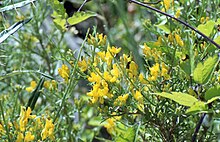
Leptospermum scoparium, commonly called mānuka, mānuka myrtle, New Zealand teatree, broom tea-tree, or just tea tree, is a species of flowering plant in the myrtle family Myrtaceae, native to New Zealand and south-east Australia. Its nectar produces Mānuka honey.

Genista stenopetala, the sweet broom, Easter broom or leafy broom, is a species of flowering plant in the legume family Fabaceae, native to the Canary Islands, on La Palma and Tenerife.
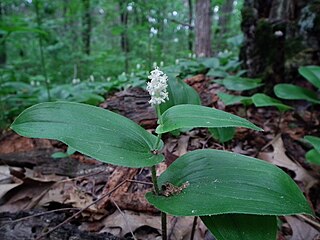
Maianthemum canadense is an understory perennial flowering plant, native to Canada and the northeastern United States, from Yukon and British Columbia east to Newfoundland, into St. Pierre and Miquelon. It can be found growing in both coniferous and deciduous forests. The plant appears in two forms, either as a single leaf rising from the ground with no fruiting structures or as a flowering/fruiting stem with two to three leaves. Flowering shoots have clusters of 12–25 starry-shaped, white flowers held above the leaves.

Juniperus thurifera is a species of juniper native to the mountains of the western Mediterranean region, from southern France across eastern and central Spain to Morocco and locally in northern Algeria.

Jasminum polyanthum, the many-flowered jasmine, pink jasmine, or white jasmine, is a species of flowering plant in the olive family Oleaceae, native to China and Myanmar. A strong evergreen twining climber, it is especially noted for its abundant, highly fragrant pink to white flowers.

Veronica hederifolia, the ivy-leaved speedwell, is a flowering plant belonging to the family Plantaginaceae. It is native to Europe, western Asia and north Africa and it is present in other places as an introduced species and a common weed. Solitary blue flowers occur in leaf axils, each with a corolla up to one centimetre (0.4 in) wide. The fruit is a dehiscent capsule.

Grevillea wilsonii, also known as Wilson's grevillea or native fuchsia, is species of flowering plant in the family Proteaceae and is endemic to the south-west of Western Australia. It is an erect shrub with deeply divided leaves, the end lobes linear, and erect, more or less spherical clusters of red flowers

Bromus secalinus is a species of bromegrass known as rye brome. The specific epithet secalinus is Latin, meaning "rye-like". The fruits are hard, rounded glumes that appear superficially similar to the rye grain, which gives the brome its common and scientific name. The grass has a diploid number of 28.

Dudleya densiflora is a species of succulent plant in the family Crassulaceae known commonly as the San Gabriel Mountains liveforever or San Gabriel Mountains dudleya. A very rare plant confined to the San Gabriel Mountains of Los Angeles County, California, it is known only from three to five spots in the mountain range, with an estimated 1,700 individual plants remaining. Growing in the cracks of the granite slopes of three canyons in this single mountain range, it is threatened by human activity such as rock quarrying and off-trail recreation.

Bromus madritensis is a species of brome grass known by the common name compact brome. The specific epithet madritensis refers to Madrid, Spain. It has a diploid number of 28.

Dudleya variegata is a deciduous succulent plant in the family Crassulaceae known by the common names variegated liveforever, variegated dudleya or rarely San Diego Hasseanthus. A cryptic plant that survives part of the year dormant underground from starch reserves in a corm, after sufficient rainfall, leaves will emerge, soon giving way to small inflorescences with yellow star-shaped flowers. It is native to Baja California and adjacent San Diego County in California, where it grows in several habitat types, including chaparral and vernal pools.

Pimelea alpina, the alpine rice-flower, is a species of flowering plant in the family Thymelaeaceae and is endemic to south-eastern continental Australia. It is an erect, prostrate or spreading shrub or undershrub with narrowly elliptic leaves crowded at the ends of branches and heads of pinkish red or white flowers.

Cryptostylis erecta, commonly known as the bonnet orchid or tartan tongue orchid , is an orchid endemic to south eastern Australia. A small and common plant, it has dark green lance-shaped to egg-shaped leaves and up to twelve greenish flowers with a large, bonnet-like or hood-like, lilac-coloured labellum with a network of purple veins.
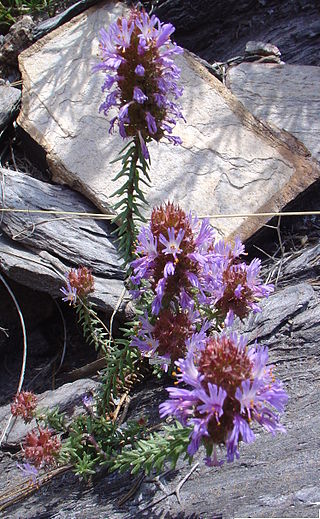
Coris monspeliensis, also known as Montpelier [sic] Coris, a plant species in the primrose family, has erect or ascending stems which are woody at the base and densely covered with foliage. The leathery linear leaves, which grow up to 20 mm long are alternate and stalkless. They may be hairless or hairy and the highest leaves often have small teeth. The flowers with 5 unequal petals, each deeply lobed are borne in short dense clusters and vary in color from pink to blue. Each flower measures up to 12 mm across and has narrow, widely spread petals. The calyx is bell shaped and has up to 20 red or black spiny teeth. The spherical capsule is up to 2 mm in diameter.

Persoonia hirsuta, commonly known as the hairy geebung or hairy persoonia, is a plant in the family Proteaceae and is endemic to eastern New South Wales. It is a hairy, spreading to low-lying shrub with linear, lance-shaped or spatula-shaped leaves and yellow or orange flowers arranged singly or in groups of up to ten on a rachis up to 20 mm (0.79 in) long.
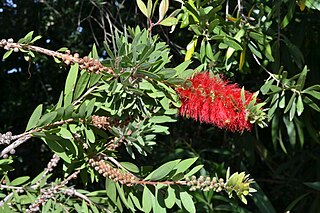
Melaleuca citrina, the common red bottlebrush, crimson bottlebrush, or lemon bottlebrush, is a plant in the myrtle family Myrtaceae, and is endemic to eastern Australia. Some Australian state herbaria continue to use the name Callistemon citrinus. It is a hardy and adaptable species, common in its natural habitat. It is widely cultivated, not only in Australia. It was one of the first Australian plants to be grown outside the country, having been taken to England in 1770 by Joseph Banks. Its showy red flower spikes, present over most of the year in an ideal situation, account for its popularity.
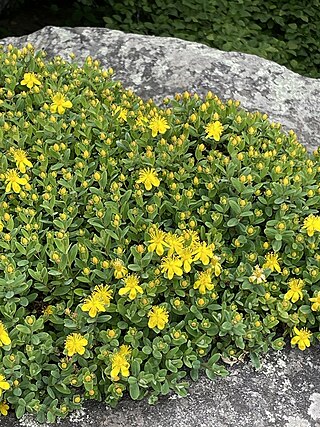
Hypericum buckleyi, known as Blue Ride St. John's wort and Buckley's St. Johnswort, is a rare species of flowering plant in the family Hypericaceae found only in the Appalachian Mountains of the southeastern United States. The species is listed in the state of Georgia (S1), South Carolina (SX), and North Carolina (S3).
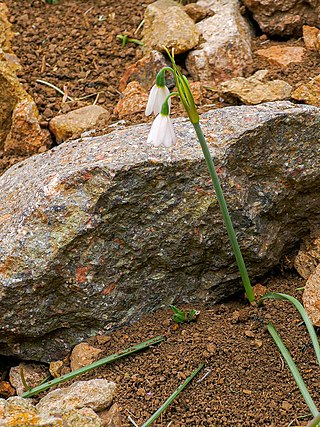
Acis longifolia is a species of flowering plant in the family Amaryllidaceae, endemic to Corsica. Its white flowers appear in spring. It is sometimes cultivated as an ornamental plant, but is not fully frost-hardy.
Hypericum cuisinii is a perennial herb in the genus Hypericum, in the section Adenosepalum. The herb has pale yellow flowers and occurs in Greece and Turkey.

The Regino River is a small coastal river in the department of Haute-Corse, Corsica, France.
